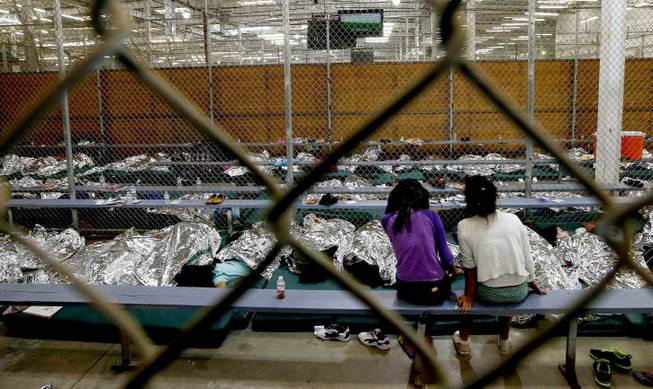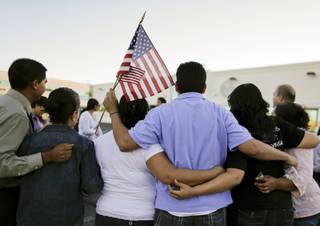
Ross D. Franklin / AP
Two girls watch a World Cup soccer match on a television from their holding area, where hundreds of mostly Central American immigrant children are being processed and held at the U.S. Customs and Border Protection Nogales Placement Center on Wednesday, June 18, 2014, in Nogales, Ariz. The girls are among tens of thousands of immigrants who have flooded over the Southwest border this year, many unaccompanied children. Now, a Reno-based advocate for immigrants says the tide of immigrants is beginning to reach Nevada.
Thursday, July 17, 2014 | 2 a.m.
Every time the phone rings these days, Rosa Molina steels herself for a heart-wrenching story.
She has been taking far more calls than usual from immigrants, and many of them are sharing tales of abuse and violence. This week, she has already taken a call from a mother who says she paid a smuggler $7,000 to escort her children from El Salvador to the United States, only to be contacted and asked for an additional $5,000 if she ever wants to see her children again.
“The problem started last year, but nobody was paying attention,” said Molina, director of the citizenship and immigration program for the Progressive Leadership Alliance of Nevada in Reno. She connects immigrants with pro bono attorneys, a high-demand service in the area.
The surge of immigrants, mostly children and families from Central America, only recently became fodder for newscasts but has been building for years. Apprehensions of unaccompanied children increased from 16,067 in fiscal year 2011 to 24,481 in FY 2012 and 38,833 in FY 2013, according to Customs and Border Patrol.
The numbers have spiked this year, with 57,525 picked up by Border Patrol in the first nine months of FY 2014. If the increased rate holds, the federal government estimates 90,000 children may arrive before the fiscal year ends Sept. 30.
Molina’s phone was ringing at 10 times the normal rate last year, and she noticed a lot more calls pertaining to recently arrived children and families. Then the flood hit at the end of spring. The office received more than 120 calls in June alone — a 260 percent increase from normal traffic.
Nevada is not home to any of the government-contracted shelters or other facilities being used for the recently arrived immigrants, but it has not been untouched by the influx.
“Last year, we were seeing more kids traveling alone, mostly between 10 and 14 years old, that were being sent here by immigration authorities because they had family in the area,” Molina said. “Now, we are seeing a lot of women and children together, with the kids as young as 5 years old.”
Typically, the immigrants who show up in Northern Nevada and the Lake Tahoe area have been detained near the Mexican border by immigration authorities and released with a notice to appear in court for deportation proceedings. In Nevada, most end up staying with friends and family.
A survey by the United Nations High Commissioner for Refugees of 400 unaccompanied children found 48 percent experienced violence or threats by organized-crime groups, including gangs, drug cartels and officials in their home countries. An additional 22 percent reported experiencing abuse at home and violence from their parents or guardians. Family reunification is also a motivating factor, with 81 percent of the minors surveyed saying they migrated to join a family member or pursue better opportunities.
The children are not just fleeing to the United States. From 2008-13, there was a 712 percent increase in asylum application from citizens of El Salvador, Honduras and Guatemala to countries other than the United States.
“At the heart of the current situation is a simple fact,” James Ziglar, former commissioner of Immigration and Naturalization Services, said in a media conference call Wednesday. “(People from) the northern triangle of Central America are fleeing violence and persecution. In particular, what we’re seeing is they are trying to get kids to safety. By any definition I know of, these people are refugees.”
Smugglers have also been spreading misinformation, Molina said, based on her interviews with the immigrants calling her office.
“They are telling them that if they get here by July 30, the U.S. government will let them stay, which is obviously not true,” Molina said.
It’s too soon to tell how many of the recent arrivals in Northern Nevada will qualify for asylum or other protections under immigration law, Molina said, but several people who contacted her shared stories of abuse either at home or during their journey north. Under U.S. law, victims of trafficking and violence may be eligible for special visas or asylum.
The majority of unaccompanied children are placed with a relative or parent in the country while they await their court hearing, and those with no guardian are transferred from Immigration and Customs Enforcement custody to the U.S. Health and Human Services Office of Refugee Resettlement, which transfers them to shelters. However, there are not enough shelter beds and the government has had to use temporary facilities, such as military bases, to house the immigrants.
Las Vegas area pastors Kathryn Obenour and Joel Menchaca, of Mary Magdalene Friends United Church of Christ and Amistad Cristiana Church respectively, visited a Naval base used as a temporary holding facility in Port Hueneme, Calif., with a coalition of faith leaders. The Las Vegas pastors did not get to go inside Naval Base Ventura County for the tour but said their compatriots reported that the conditions for the immigrants were good.
However, the deluge of immigrants has jammed the gears of an already strained processing and judicial network for immigration, Obenour said. There are not enough beds for the children, not enough people to process them and not enough judges to get the cases adjudicated promptly.
“If nothing else, in my opinion we need more resources, more people working on these jobs,” Obenour said. “This should not be about sending them into harm's way and getting rid of them as quickly as possible. If we are not a country of people that care about people, shame on us. When children come to us for safety, by golly we need to be there.”
Obenour and Menchaca are collecting clothing and toiletries for the immigrants that will be distributed through a San Diego-based nonprofit organization.
Others, like protesters who blocked a bus delivering immigrants to a facility in Murrieta, Calif., and politicians such as Rep. Bob Goodlatte, R-Va., say the children should be sent back as fast possible to “send a clear message” to any others thinking of attempting the perilous journey themselves.
President Barack Obama has asked for $3.7 billion to address the problem through a combination of measures augmenting border security, detention, removals and immigration courts, as well as funding to assist the immigrants’ countries of origin.
Congress has not approved the funds and is considering a bicameral bill from Sen. John Cornyn, R-Texas, and Rep. Henry Cuellar, D-Texas, that would streamline the process for repatriating child immigrants from countries other than Mexico and Canada, which already have a different process.
The bill would require children requesting to remain in the country to file a legal claim with an immigration court within a week of being screened by Health and Human Services personnel. A judge would then have 72 hours to make a decision about whether the child is eligible to stay in the U.S. or should be sent back to his or her home country.
A Pew Research Center poll released Wednesday found 53 percent respondents want the U.S. government to speed up the process even if that means some people eligible for asylum are deported.
Experts on refugees said the plan would put children in jeopardy, as it can take months before immigrants open up about abuse.
“Since the time of our research the flow has gotten larger, the children are younger and there are a lot more girls,” said Leslie Velez of the United Nations High Commissioner for Refugees, which conducted the survey of unaccompanied children at the end of 2013.
“We are concerned that the lives of those children could be risked if they are returned … within this context what we’d want is for victims of harm to have the chance to explain why they fled and have the opportunity to seek asylum if they fear for their safety.”
By the numbers
• 57,525 — Unaccompanied children apprehended at the Southwest border in the first nine months of FY 2014, already a 106 percent increase from all of FY 2013.
• 55,420 — Family units apprehended at the Southwest border in the first nine months of FY 2014, a 493 percent increase from all of FY 2013.
• $3.7 billion — Funding that Obama has requested to help address the crisis, including money to hasten deportations, improve border security, increase immigration court capacity and provide aid to the three main source countries for the recent influx: El Salvador, Honduras and Guatemala.
• 5,000 — Beds available for unaccompanied children in shelters contracted by the Office of Refugee Resettlement, which takes custody of immigrant minors who have no guardian in the country.
• 43 — Percentage of children who appeared before immigration court without legal representation since 2005.
• 71 — Percentage of unaccompanied children since 2005 who were either ordered removed or chose to voluntarily leave the country at the end of their court cases.
Sources: Customs and Border Patrol; National Center for Border Security and Immigration at University of Texas, El Paso; Transactional Records Access Clearinghouse at Syracuse University


Join the Discussion:
Check this out for a full explanation of our conversion to the LiveFyre commenting system and instructions on how to sign up for an account.
Full comments policy